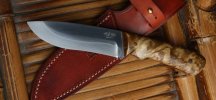Ok as promised Master Chen has allowed me to show you his incredible process for making swords and Knives ( for the American Market) Many master Sword Smiths in Asia and points east will not share these secrets to anyone but their apprentice. Since Master Chen is self taught he has no master. Ala Pen and Teller he can show us how his magic is performed. However his craft is not slight of hand...
So lets begin..
First Master Chen begins with Iron Sand that he mines himself out of the indegeonous Rock Strata from where he lives...
Into the smelter it goes...this process fires the sand to extreme temp to remove the metal from the sand..
as the smelting process begins the higher carbon steels will stay to the bottom of the smelter. The Slag lower carbon material will float near the top..
in this picture the high carbon steel is being extracted painstakingly from the smelter...
From over ( and maybe Bobby you could jump in here with actual kilo weight) but I believe that over 240lbs of sand a 15lb billit of appropriate usable steel is extracted. Note the molten steel is carefully carried...to...
a rapid quench in cold water...this cools the steel very fast and makes it very brittle...
Thus making it easy to further remove impurities and low carbon impurities..In this picture the billit is now smashed with a sledge hammer and the two colors of steels...dark black and Gray are seperated. Again if Bobby could jump in and say which is which I would appreciate...
More tomorrow...stay tuned..



















